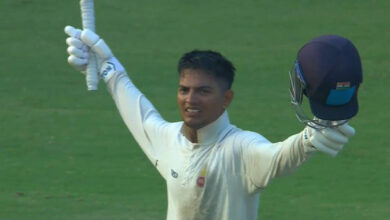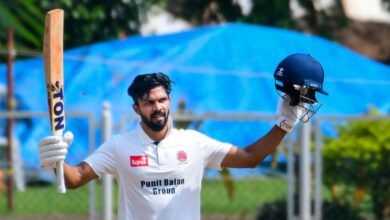Biomechanics of the big-hitting of Pandya, Buttler and Livingstone, and what works for them

My philosophy: White-ball batting is hand-eye coordination with power and skill. When you bat, you lead with your head. When you hit, you lead with your hip more. It’s about generating power ground-up, from the hip to the hands. Cricket has been traditionally too hand-reliant. That has to change. Power comes from the torso and hips. A kinetic chain of energy happens when you hit the ball explosively: it comes up from your back leg to your hip, to your back, goes to your shoulder, elbow, and finally to your wrs. What I try to do is to join the dots up. You need to separate your hands from your body. You need to do that separation to improve explosiveness. You see that in baseball, the back leg goes back, hands are separated from the body so to say, and then an explosion kicks in. You have lots of energy stored up in your wrs. For players who don’t do it naturally, I try to create it their natural movements. Using wrs is the last part of the kinetic chain of events. How to get that final snap.
I would like to see how all these hitters go about their job in Australia where the playing services are a bit bigger. They have to be aggressively smart.
Liam Livingstone
His mindset is to try to hit every ball for a six. He has no fear of failure. He needs rhythm and tempo, and timing. He gets his rhythm from his hands and when he gets it right, the whole kinetic chain stays together. That ground forces we talked about. When he gets it wrong, which is what is more important basically, his back leg basically collapses, which means he doesn’t use his back leg.When you are hitting, you want your back heels to be above your toe, then you are creating power, creating angles. But if your back leg collapses, the power doesn’t flow properly. He has got great hand-eye coordination and is backing his hands. If you commit to the shot, you are putting your whole body into the shot. He has talked about hitting his longest sixes against spinners when he initially feels he has been done in the flight and still goes through it. What does it mean? The commitment takes over and the whole body flows into and the energy flows better. Even if he doesn’t quite get here, he can drag it for a six; his hands do the work in the end. But his best comes when his back leg is positioned well and kickstarts the hips into the action.
Jos Buttler
He is the best batsman in the world at the moment, arguably the best T20 batter of all time. He has the greatest wr-snap out there. At the start of the innings he can be quite conventional, stay side-on, see the swing and pace, and once he has got his eye in, he opens up a touch. He can access every part of the ground, he has the same swing (as Liam) but he can hit different planes, depending on length and line. He can open up the off side and of course he can go leg side and he has all those scoops.
You have lots of energy stored in your wr. His wr-snap is the best out there. And he doesn’t try to hit under the ball but almost undercut it slightly so that the ball gets more air-time, stays longer and clears the field. With slightly under-cutting, you get a lot of backspin on the ball which basically takes the ball out of the field. It’s a thing in baseball. You don’t get too under the ball and only get elevation, but hit it at an angle that gains more airtime and travels longer. Buttler has a pure bat swing and it looks so effortless. It’s a bit like a slice, but from a different angle of course. You don’t want to undercut too much; it’s a scientific art.
Glenn Maxwell
He has this ability to separate his hands from the body. He has strong massive forearms on him. And he commits to every shot. To me, he has to keep it simple., Don’t tamper too much. He seems very instinctive and needs to go with it rather than tinker around. separating the hands from the body I mean this: When he lifts his bat up, he has a great set-up. His hands go behind him, his hands are above his front elbow which gives you a great launch-pad. It’s like golf, you don’t hit 400 yards just getting the club down; there is a hand-hip separation and Maxwell does that pretty well.
Hardik Pandya
Very quick hands. Very quick movements – feet too to get into great positions. He knows what he likes to do. And what he does well is, if the ball isn’t there for the position he has set himself up for – say on the off-stump guard, opened-up stance and in theory looking to hit to the leg side- he is still in great position to hit it somewhere else. We have often seen the bowlers try bowling wider, away from him, and he smashes it to the point boundary. The best ones are the proper batters; like Pandya, like Buttler. They have great awareness about their batting and it helps massively. Hardik has such quick hands, see some of the cuts or the leg-side drags; he slashes them almost. He swoops down well on the outside-off yorkers; he is seriously quick.
Another interesting thing you notice about Pandya, and this is true of many of these big hitters like Buttler, is that these guys hit straight but don’t play straight. They play with a slight angle of the bat, which gives more options. Hit straight, but don’t play straight.It also helps in under-cutting the ball. You can only undercut if you are at a slight angle. When you play straight, up and downward swing of the bat in line, as you might have seen in the olden days, the ball can go straight up or get more elevation than needed. You can see it still with the more conservative-or-conventional oriented batsmen. They can punch the ball but when they go beyond that, and are looking for aerial elevation, that technique fails. You need to come at the ball at an angle and you see that in all these players.
David Miller
He gets into good positions and stays there. As in you don’t see him go out of shape, when he is hitting well. He doesn’t get too close to the ball. He can play straight but he can also manoeuvre the ball to other areas pretty dominantly.
No unnecessary grasping or lunging at the ball. More self-confidence these days I notice waiting for the ball. He is strong and has quick hands; so he can do that. He is a proper batsman who gets access to the ball. It looks like he has worked out his game.
Rovman Powell
He is strong, built like a heavyweight boxer. He gets into positions very early and has that hands-hip separation. He has skills for scientific hitting but he is more of a power hitter. Not as skilful as some of others in the l but seems to have the ball-sense to go for his brutal swings. His role in the team is also different to the others in the l – not as much rides on him as yet as he is still growing and he is letting himself have a bit of fun, if you like. Once the bowlers start probing and analysing, then these batsmen tend to go more scientific with their hitting. But right now, he is punching them like a boxer. So strong.
Marcus Stoinis and Tim David
Stoinis is a big strong boy, more power than skill (scientific skill that is) but that doesn’t mean he doesn’t think about his hitting art. You can see him, feet close together, slightly crouching, the body like a catapult when he springs and uncoils for the big hit. So there is that thought and style; but again with his role, with the other hitters in the team, he has been free to come and do his thing. The timing of the movement is the key and when he gets it right, he connects well.
Tim David is another batsman I am looking forward to in the world cup. A batsman who has almost raised through franchise cricket. A stand-and-deliver kind of a guy, with good clean bat swing. Tall, long levers, and a simple bat swing. I haven’t seen much of Tran Stubbs; he also looks good.
If you ask me about a team of batters of power players then I have to pick England. All the way down.







